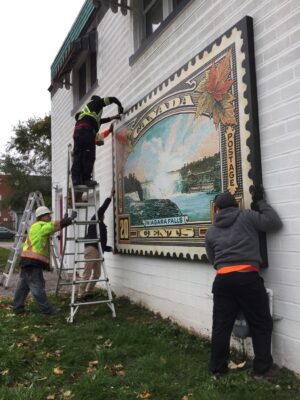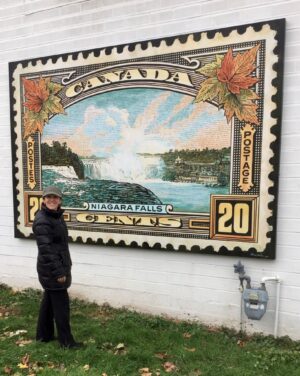
The installation.
The mural panel was temporarily installed on a wall in the author’s shop to make it easy to work on. The surface of the white ACPs was sanded with a scouring pad to remove the slippery, glossy finish and enable better paint adhesion.
Paint selection also had to be carefully considered. The paint employed for the mural had to be both quick to dry and durable, designed for long-lasting exterior applications. An acrylic paint was chosen because it fulfilled these requirements, as well as providing vibrant transparent and opaque colours.
Finally, a high-resolution stock photo of the original stamp was purchased. Two black-and-white photocopies of the stamp image were made onto clear 215 x 279-mm (8.5 x 11-in.) film sheets. One film sheet was used to create the colourized maquette by simply painting on the reverse side using a palette of vintage colours mixed with the acrylic paints.
The other film sheet was employed to project the stamp onto the wall panel using an old overhead projector. From there, the linework was traced using black permanent markers. These work well because they are waterproof and because the black lines bleed through paint, allowing artists to stay true to the original image. The marker lines also fade away in the sun quickly.
A water-soluble pencil was utilized to lightly trace in the etched lines in the water below the falls and in the sky, as a guide for placement of the permanent lettering. The letters were far too small to hand letter with a brush, so fade- and ultraviolet (UV)-resistant markers were used instead. Ideally, the marker-drawn letters would last, and the worst-case scenario would be they would eventually disappear—just as time and history fade away.
The mural’s colour palette was inspired by vintage postcards. Acrylic artist brushes were employed to quickly paint in washes of colour for the leaves, water, and sky. The solid black linework followed to clean everything up. The painting process took approximately one week, and the mural was installed before the end of the month. As a finishing touch, the author went onsite and painted the cancelled postage marks across the mural and onto the wall.
The result

Elaine with mural on wall.
Since its installation, the mural’s marker-drawn letters have almost entirely faded. Recently, the mural itself was relocated to another building on the same street, at which point the letters were added back in on wall panels alongside it. The wall the mural was moved to was stucco on foam, so the subframe required longer bolts: 8-mm (0.3-in.) butterfly clips with 152-mm (6-in.) long 8-mm bolts. Given the fact the mural was not painted directly on the wall, it was able to be saved when relocation became necessary.
The mural earned first place at the 2020 Best of Canada’s Sign Industry Awards (BOCSIes) in the Historical Sign category.
The piece remains on Queen Street, offering an engaging look back at Niagara Falls’ history.
Elaine Wallis is the principal designer and founding partner of Signature Sign & Image in Niagara Falls, Ont. She and her husband Jeff started what is now a family business from the basement of their home in 1983. The company produces all types of signs and displays, with a focus on electric and digital signage. Wallis is also a member of Walldogs, an international organization of muralists. She can be reached via e-mail at elaine@signaturesigns.ca.
Notes
1 For more information, visit postalhistorycorner.blogspot.com.





